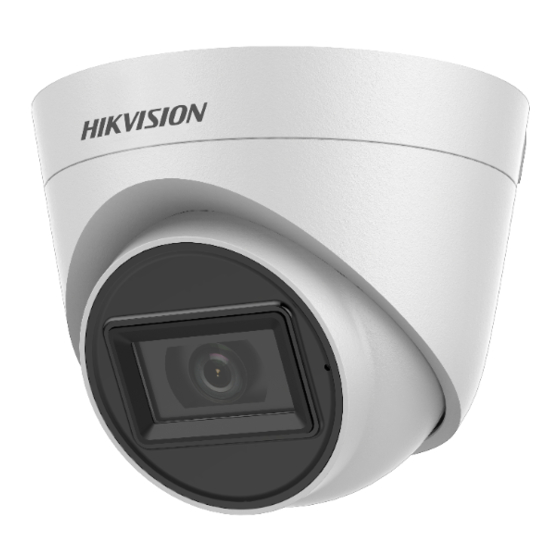- ページ 10
防犯カメラ HIKVISION D0TのPDF ユーザーマニュアルをオンラインで閲覧またはダウンロードできます。HIKVISION D0T 11 ページ。 Audio turret camera
HIKVISION D0T にも: ユーザーマニュアル (17 ページ), ユーザーマニュアル (17 ページ), ユーザーマニュアル (15 ページ), ユーザーマニュアル (11 ページ), ユーザーマニュアル (17 ページ)

Brightness refers to the brightness of the image. The
higher the value is, and more brighter the image is.
EXPOSURE MODE
You can set the EXPOSURE MODE to GLOBAL, BLC, or
HLC.
GLOBAL
GLOBAL refers to the normal exposure mode which
adjusts lighting distribution, variations, and non-standard
processing.
BLC (Backlight Compensation)
The BLC (backlight compensation) function can
compensate light to the object in the front to make it
clear, but this causes the overexposure of the background
where the light is strong.
HLC (Highlight Compensation)
HLC stands for highlight compensation. The camera
detects the strong spots (the over-exposure portion of
image), then reduce the brightness of the strong spots to
improve the overall images.
AGC (Auto Gain Control)
It optimizes the clarity of the image in poor light
conditions. The AGC level can be set to HIGH, MIDDLE, or
LOW.
Note:
The noise will be amplified when the AGC is on.
DWDR (Digital Wide Dynamic Range)
Digital wide dynamic range gives the camera the ability to
view dark areas of the given image as well as extremely
lighted portions of the image, or areas of high contrast.
WB (White Balance)
White balance, the white rendition function of the
camera, is to adjust the color temperature according to
the environment. It can remove unrealistic color casts in
the image. You can set WB mode to AUTO (ATW), or
MANUAL (MWB).
AUTO
Under AUTO mode, white balance adjusts automatically
according to the color temperature of the scene
illumination.
MANUAL
You can set the R-GAIN/B-GAIN value to adjust the
shades of red/blue color of the image.
DAY/NIGHT
You can select the DAY/NIGHT as B/W, SMART, or COLOR.
B/W
The image is black and white all the time.
SMART
SMART refers to Smart IR. The function is used to adjust
the light to its most suitable intensity, and prevent the
image from overexposure.
Figure 3-1 WB
